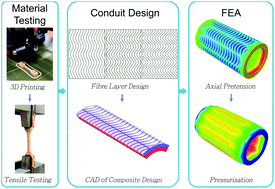In silico design of additively manufacturable composite synthetic vascular conduits and grafts with tuneable compliance
Abstract
Benchtop testing of endovascular medical devices under accurately simulated physiological conditions is a critical part of device evaluation prior to clinical assessment. Currently, glass, acrylic and silicone vascular models are predominantly used as anatomical simulator test beds for in vitro testing. However, most current models lack the ability to mimic the non-linear radial compliance of native vessels and are typically limited to being compliance-matched at a single mean pressure comparison point or not at all. Hence, a degree of caution needs to be shown when analysing results from such models under simulated physiological or pathophysiological conditions. Similarly, the clinical translation of proposed biomimetic compliance-matched vascular grafts has undoubtedly been curtailed due to performance and material limitations. Here, we propose a new design for synthetic vessels where compliance can be precisely modulated across a wide physiological pressure range by customising design parameters. Building on previously demonstrated methods of 3D printing composite compliant cylindrical structures, we demonstrate proof of principle in creating composite vascular constructs designed via a finite element model. Our constructs are 3D printable and consist of a soft silicone matrix with embedded polyurethane fibres. The fibre layer consists of circumferential sinusoidal waves with an amplitude that can be altered to result in tuneable internal radial compliances of 5.2–15.9%/mmHg × 10−2 at a mean pressure of 100 mmHg. Importantly, the design presented here allows preservation of the non-linear exponentially decaying compliance curve of native arteries and veins with an increasing mean pressure. This model offers a design toolbox for 3D printable vascular models that offer biomimetic compliance. The robust nature of this model will lead to rapidly accelerating the design process for biomimetic vascular anatomical simulators, lumped parameter model flow loops, endovascular device benchtop testbeds, and compliance-matched synthetic grafts.

- This article is part of the themed collection: Biomaterials Science Emerging Investigators 2021


 Please wait while we load your content...
Please wait while we load your content...